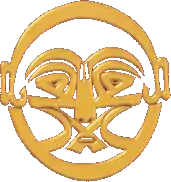Bektashism and folk religion
Folk religious practices remain in the Bektashiyyah tariqa and certain practices are also found to a lesser extent in Balkan Christianity and non-Bektashi Balkan Islam as well, according to some Western Islamic scholars.
| Part of a series on Islam Shia Islam |
|---|
 |
|
|
| Part of a series on Nizari-Ismāʿīli Batiniyya, Hurufiyya, Kaysanites and Twelver Shī‘ism |
|---|
 |
|
|
| Part of a series on Shia Islam |
| Twelvers |
|---|
|
|
Rites, rituals, and holy things in the Balkan villages common to both to Muslims and Christians
Famous archaeologist Arthur Evans, after studying ancient religions of Europe, noted that there were cults centered around the use of trees and pillars, often acting like idols. While in Macedonia he entered a temple/shrine that was maintained by Dervishes in the town of Tekekioii (possibly the tekke in modern Tetovo). He was permitted to take part in a ritual at the shrine, the focus of which was a large upright rectangular stone, possibly a "local" Kaaba. The stone was said to have fallen from heaven, and it was venerated or at least respected by Muslims and Christians in the region. It was stained black by years of being anointed with holy oils. The stone was around 6.5 ft (2 m) tall, with a second smaller stone placed on top of it and a sash tied like a belt around it. A sick man was circumambulating the pillar, kissing and hugging it at each pass. In a ritual connected to it, a person prays before the stone, hugs it, draws water from a nearby spring, and climbs a small hill at the top of which is an Islamic "saint's grave". Growing over the grave is a thorn tree, which has rags and fabric hanging from it placed there by the sick seeking divine cures. The water is poured into a hole in the center of the grave, mixed with grave-dirt, and then the suppliant drinks this mixture three times, then anoints their head three times. Then a circumambulation around the grave is started, with three passes, each time kissing and touching with the forehead "the stone at the head and foot of it". Afterwards, grave dust was given to Evans, to be made up into a triangular amulet. The Dervish then cast some pebbles, read them (divination) as falling good, a priest sacrificed a ram outside the grave site, with the blood of the ram used to anoint the forehead of the suppliant. Finally, Evans was instructed to give something to attach to the pillar overnight, and he himself resides with the stone and his guide, lighting candles after sunset and eating the sacrificial ram.[1]
Pre-Islamic influences
In addition to schools of Islamic thought, the Bektashis in Turkey and the Balkans also maintain ancient practices from pre-Islamic societies. For instance, upon visiting the village of Haidar-es-Sultan and Hassan-dede in the summer of 1900, enthographer J.W. Crowfoot witnessed survivals of the ancient Hero Cult and the pythian oracle.[2]
In Haidar-es-Sultan, an old Bektashi woman would inhale the sulfurous fumes of a special well in the center of the town, and go into an ecstasy in which she would divine a person's future, much like at the Oracle at Delphi. This well was also associated with a central tomb, which stood out from other local graves in the town because it wasn't neglected and it was given special care. At Hassan-dede there was also a central tomb, maintained by a family that stated that they were direct descendants of the occupant of the tomb, who had come from Korashan. These are elements that are strongly associated with the older pagan Hero Cults of that area. For example, Mycenaean royalty were buried in tombs and worshipped for centuries later.[3] The Balkans and Anatolia also shared this common pattern of saint veneration, as shrines in Macedonia were used in both Muslim and Christian traditions.[4]
Influences on Zoroaster and Yazidis' conviction
Furthermore, some pre-Islamic accounts note that the people in these Bekthashi regions of Turkey are not native and that they originally come from Babylon. Their 'piety' is handed down from father to son and they have unusual institutions (which might very well be referring to initiation rituals and the rites of the mystery religions). These pre-Islamic peoples considered fire to be divine, and they mark as the founder of their nation a man named "Zarnuas", which appears to be a derivations of Zoroaster. They were also said to be "prey to the devil", which is what followers of pagan religions were usually condescendingly referred to as. The Bektashi of this region are noted to, in modern times, always use two hands when drinking wine, even if the cup used is small enough to make this unnecessary. Such a trait is also exhibited by the Yazidis of northern Iraq, and is thought to also be a survival of pre-Islamic times, when the special cups used for drinking wines contained two large handles. Unusually, the ancient inhabitants of the region also were noted for having extreme ear piercings, and the Bektashi of the hills of Turkey also keep this tradition.
Nevertheless, such beliefs and practices are not particular to Bektashism and they form, rather, part of a larger Balkan and Turkish pre-Islamic and pre-Christian tradition.
Influences of the faith of the Baktāsh’īyyah and Qizilbāsh tāriqāt on the folk religion throughout Anatolia and the Balkans
| The historical emergence of the Shī‘ah Imāmī Alevī-Bektaşi Ṭarīqah |
|---|
Notes
- Evans, A. 1901. Mycenean Tree and Pillar Cult and its Mediterranean Relations. The Journal of Hellenic Studies. 21. pp99-204.
- Crowfoot J.W. 1900. Survivals among the Kappadokian Kizilbash (Bektash). The Journal of the Anthropological Institute of Great Britain and Ireland. 30. pp305-20.
- Antonaccio, Carla M (1994). "Contesting the past: hero cult, tomb cult, and epic in early Greece". American Journal of Archaeology: 390.
- Filipova, Snežana. "Notes on the continuous multi-confessional use of shrines, cult places, Christian relics and springs of holy water in the Republic of Macedonia". Cite journal requires
|journal=(help) - Balcıoğlu, Tahir Harimî, Türk Tarihinde Mezhep Cereyanları – The course of madhhab events in Turkish history, (Preface and notes by Hilmi Ziya Ülken), Ahmet Sait Press, 271 pages, Kanaat Publications, Istanbul, 1940. (in Turkish)
- Ocak, Ahmet Yaşar XII yüzyılda Anadolu'da Babâîler İsyânı – Babai Revolt in Anatolia in the Twelfth Century, pages 83–89, Istanbul, 1980. (in Turkish)
- "Encyclopaedia of Islam of the Foundation of the Presidency of Religious Affairs," Volume 4, pages 373–374, Istanbul, 1991.
- Balcıoğlu, Tahir Harimî, Türk Tarihinde Mezhep Cereyanları – The course of madhhab events in Turkish history – Two crucial front in Anatolian Shiism: The fundamental Islamic theology of the Hurufiyya madhhab, (Preface and notes by Hilmi Ziya Ülken), Ahmet Sait Press, page 198, Kanaat Publications, Istanbul, 1940. (in Turkish)
- According to Turkish scholar, researcher, author and tariqa expert Abdülbaki Gölpınarlı, "Qizilbashs" ("Red-Heads") of the 16th century – a religious and political movement in Azerbaijan that helped to establish the Safavid dynasty – were nothing but "spiritual descendants of the Khurramites". Source: Roger M. Savory (ref. Abdülbaki Gölpinarli), Encyclopaedia of Islam, "Kizil-Bash", Online Edition 2005.
- According to the famous Alevism expert Ahmet Yaşar Ocak, "Bektashiyyah" was nothing but the reemergence of Shamanism in Turkish societies under the polishment of Islam. (Source: Ocak, Ahmet Yaşar XII yüzyılda Anadolu'da Babâîler İsyânı – Babai Revolt in Anatolia in the Twelfth Century, pages 83–89, Istanbul, 1980. (in Turkish))
Further reading
- Alevi / Bektashi history
- Birge, John Kingsley (1937). The Bektashi order of dervishes, London and Hartford.
- Brown, John (1927), The Darvishes of Oriental Spiritualism.
- Küçük, Hülya (2002) The Roles of the Bektashis in Turkey’s National Struggle. Leiden: Brill.
- Mélikoff, Irène (1998). Hadji Bektach: Un mythe et ses avatars. Genèse et évolution du soufisme populaire en Turquie. Leiden: Islamic History and Civilization, Studies and Texts, volume 20, ISBN 90-04-10954-4.
- Shankland, David (1994). “Social Change and Culture: Responses to Modernization in an Alevi Village in Anatolia.”In C.N. Hann, ed., When History Accelerates: Essays on Rapid Social Change, Complexity, and Creativity. London: Athlone Press.
- Yaman, Ali (undated). "Kizilbash Alevi Dedes." (Based on his MA thesis for Istanbul University.)
- Bibliographies
- Vorhoff, Karin. (1998), “Academic and Journalistic Publications on the Alevi and Bektashi of Turkey.” In: Tord Olsson/Elizabeth Özdalga/Catharina Raudvere (eds.) Alevi Identity: Cultural, Religious and Social Perspectives, Istanbul: Swedish Research Institute, pp. 23–50.